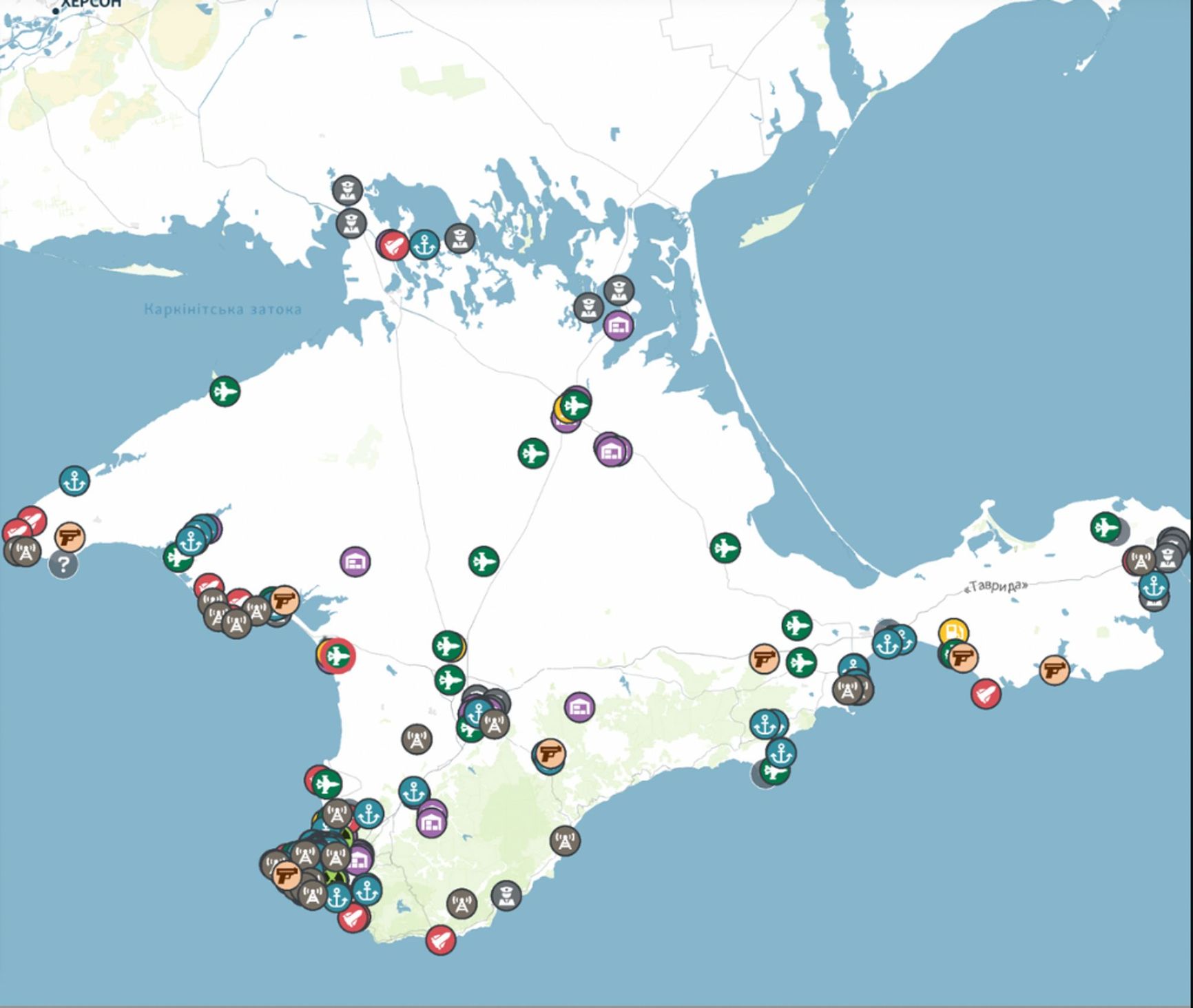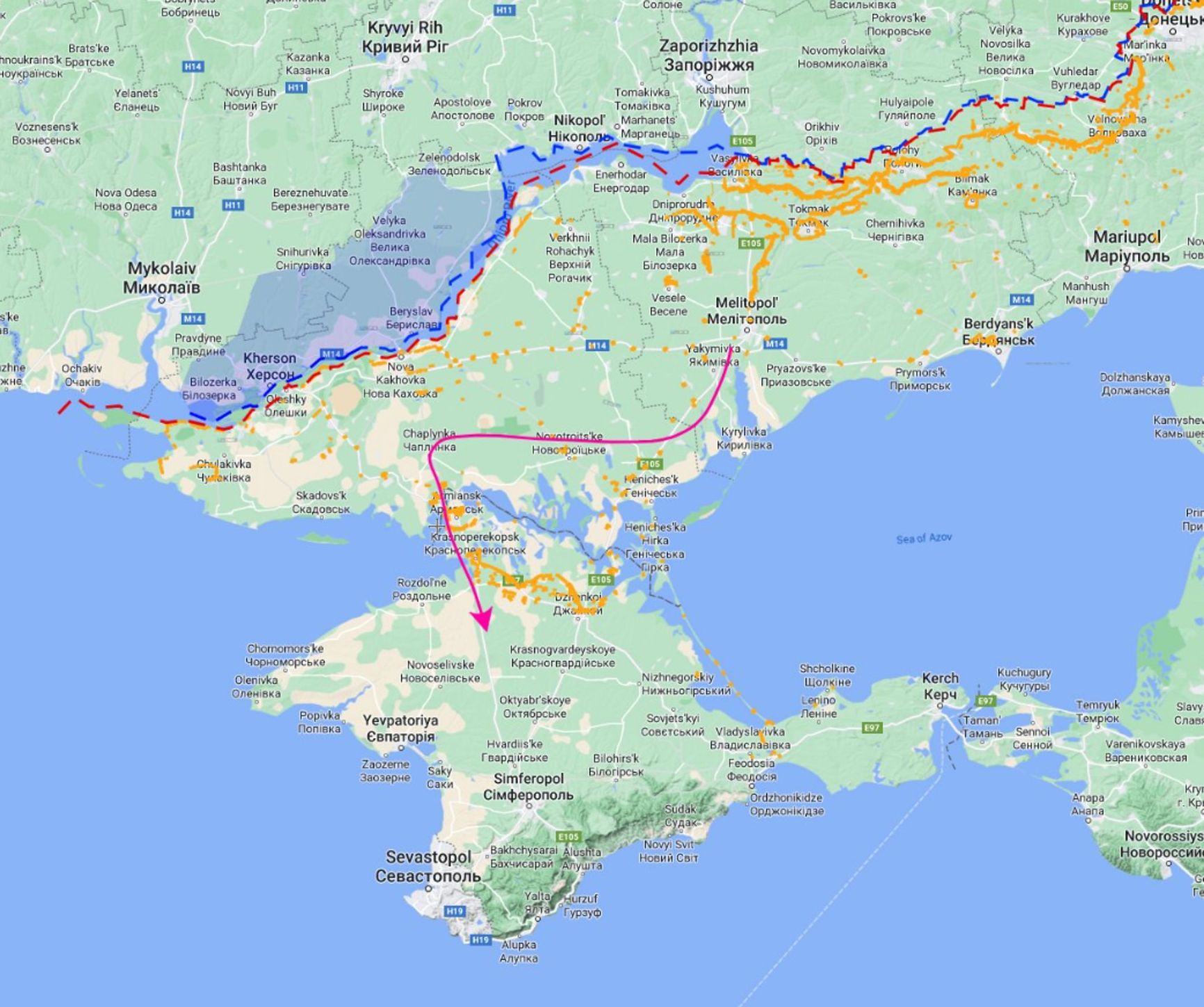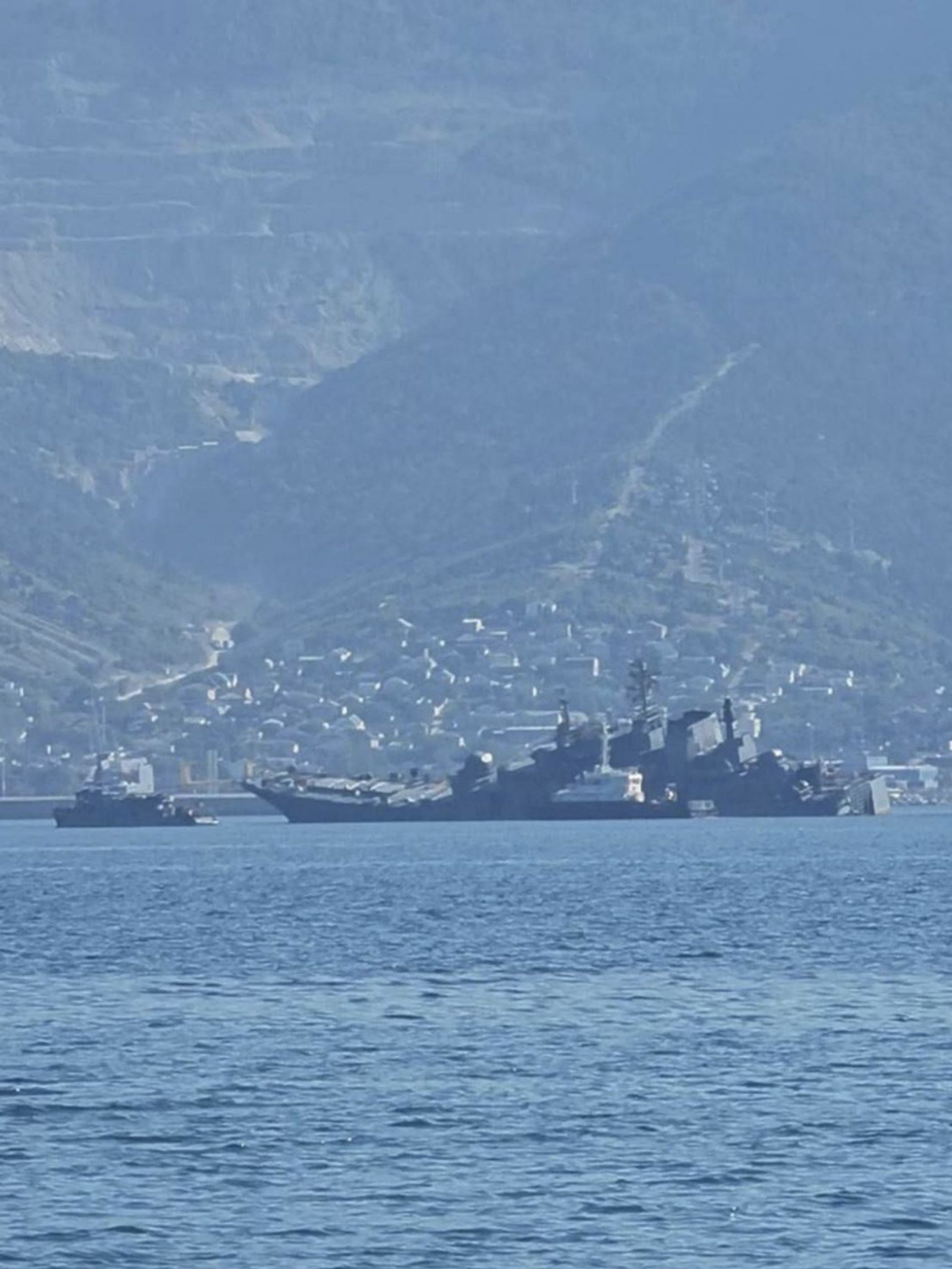

Amid the ongoing Ukrainian counteroffensive, spanning more than two months, a narrative of higher significance unfolds beyond the battles in the Zaporizhzhia and Donetsk regions and along the left bank of the Dnieper River. Through systematic strikes on communication networks, the Ukrainian Armed Forces have come remarkably close to severing transportation links and effectively isolating the Crimean Peninsula. Playing a pivotal role in this scenario are the air-launched cruise missiles known as Storm Shadow and the kamikaze sea drones.
Content
Why is Crimea important for the Ukrainian counteroffensive?
How can Ukrainians establish fire control over the peninsula?
Will it be possible to completely isolate Crimea from Russian territory?
How might Russia respond?
Could Crimea face a fate similar to Snake Island?
Why is Crimea important for the Ukrainian counteroffensive?
The Crimean Peninsula is situated at a considerable distance from the area where Ukrainian forces are conducting their offensive operations—namely the Zaporizhzhia and Donetsk regions, and even the left bank of the Dnieper River, which occasionally sees the infiltration of sabotage and reconnaissance groups. However, it's Crimea that assumes a pivotal role when it comes to upholding the combat capabilities of Russian forces in these directions.
Based on Ukrainian reports, up to 60% of supplies to Russian military units operating in the Kherson and Zaporizhzhia regions are channeled through the Crimean Peninsula. It serves as a conduit for supply routes, housing command centers, logistical support bases, and ammunition depots. Ukrainian military expert Leonid Dmitriev, , underscored the peninsula's importance in an interview with The Insider:
“It functions as the rearward base for the accumulation, recovery, coordination, and provisioning of combat activities by the occupying group in southern Ukraine—both its maritime and aerial components. It also serves as launch pads for missile strikes, aviation, and UAVs targeting Ukrainian territory. Additionally, control over the peninsula enforces a blockade on specific seaports in the northwestern part of the Black Sea.”
As per estimates by the Ukrainian service of Radio Liberty, the Crimean Peninsula hosts seven training grounds, eleven fuel depots, twenty-four airbases, twenty-six installations for air defense and missile units, twenty-seven communication and radar stations, forty-six ammunition storage facilities, logistical storage points, and fifty-eight facilities tied to the Russian Black Sea Fleet.

Location of military facilities within the Crimean Peninsula
Consequently, the strategic goal of isolating Crimea, disrupting its dependable transport connections with Russia's mainland—whence military cargo flows—and with mainland Ukraine, where Russian forces are presently on the defensive, takes precedence. This objective is conceivably even more critical than making direct advances on the frontline.
How can Ukrainians establish fire control over the peninsula?
At the beginning of August, a representative of the Odessa Regional Military Administration, Sergey Bratchuk, made a notable statement: according to him, there is no longer a single safe place left on the Crimean Peninsula where the Ukrainian Armed Forces (UAF) couldn't deliver strikes using long-range weapons.
If we look at confirmed instances of attacks on various targets in Crimea and Sevastopol over the past months, it's hard not to agree with Bratchuk's assessment.
First and foremost, in July and August, the focus of attacks has been on the road and railway bridges connecting Crimea and the Arabat Spit to the mainland of Ukraine, which is now occupied by Russian forces, specifically the Kherson region—Chongar and Henichesk.
While the damage can't be considered critical, and the Russians managed to quickly set up a pontoon crossing, a significant portion of cargo traffic from Crimea has been redirected onto the road through Armyansk. However, this route is longer and falls within the range of highly accurate and long-range missiles such as GMLRS for the HIMARS and M270 MLRS systems available to the Ukrainian Armed Forces.

Roads linking Crimea and mainland Ukraine according to Def Mon
Around 15 incidents involving missile attacks or drone strikes on targets within Crimea have been documented between July and August. Notably, various ammunition storage sites, a repair facility, and an oil depot were verified as being successfully hit.
The Crimean Bridge, in particular, holds significance not only for its logistical implications but also symbolically. It was first compromised on October 8, 2022, using a truck laden with explosives. The resulting explosion rendered the road and rail connection unusable for a substantial period. The second efficacious attack took place on July 17, 2023, executed by sea drones (with minimal railway damage this time).
On August 12, multiple missiles for S-200 systems converted for striking land targets were intercepted near the bridge. Images of the bridge shrouded in smoke quickly circulated on social media as smoke screens were deployed. Notably, this attack was carried out in broad daylight as a deliberate show of force.
The campaign of extensive aerial strikes against targets in Crimea and its surrounding areas employs air-launched cruise missiles known as Storm Shadow (referred to as SCALP-EG in its French version, which stands for Système de Croisière Autonome à Longue Portée - Emploi Général). The United Kingdom announced the transfer of Storm Shadow missiles on May 11, while France made the declaration on July 11. The missile carries a 450 kg warhead and is believed to have a range of approximately 300 km. Currently, this weapon stands as the most formidable long-range asset in the Ukrainian Armed Forces' arsenal.
Thus, over the past three months, through the use of missile and drone strikes, the Ukrainian command has indeed managed to significantly advance the cause of isolating the peninsula. Once the conflict zone is fully isolated, it becomes impractical to transfer equipment or replenish reserves, effectively rendering defense nearly impossible. The Russian army demonstrated the practical implications of this scenario last autumn by abandoning its foothold on the right bank of the Dnieper River, including the only regional center captured during the ongoing war, Kherson, after sustained strikes by the Ukrainian Armed Forces on bridges.
Will it be possible to completely isolate Crimea from Russian territory?
Even if we were to assume that Ukrainians succeeded in disrupting the road and rail links to the Crimean Peninsula, including the bridge over the Kerch Strait, maritime transportation options still remain. According to Ukrainian estimates, the ferry crossing could meet only 8-10% of the transportation needs of the Russian grouping in Crimea, but it might be feasible to establish supply lines using ships.
In conjunction with this, the heightened activity of unmanned kamikaze boats (KDBs) seems far from coincidental. This activity coincides with the deployment of Storm Shadow/SCALP-EG air-launched missiles.
Starting from May 24, 2023, reports indicate six instances of KDB attacks on ships and vessels in the Black Sea:
- On May 24, approximately 140 km northeast of the Bosphorus, three KDBs targeted the medium reconnaissance ship Ivan Khurs
- On June 11, around 300 km southeast of Sevastopol, six KDBs attacked the medium reconnaissance ship Priazovye.
- On July 25, about 370 km southwest of Sevastopol, two KDBs attacked the patrol ship Sergey Kotov.
- On August 1, roughly 340 km southwest of Sevastopol, three KDBs attacked the ship Sparta and the patrol ships Sergey Kotov and Vasily Bykov.
- On August 4, at the anchorage of the Novorossiysk naval base, a KDB attacked and damaged the large landing ship Olenegorskiy Gorniak, which was previously employed for vehicle transportation to the peninsula.
- On August 5, around 50 km south of the Kerch Strait, a KDB attacked and damaged the tanker Sig, subject to US sanctions for supplying fuel to the Russian grouping in Syria.

The large landing ship Olenegorskiy Gorniak after encountering a Ukrainian kamikaze sea drone
As evident, the activity of Ukrainian kamikaze sea drones has sharply escalated. They are not only targeting military vessels on the open sea and at a significant distance from the shore but also directly within the anchorage of naval bases (as in the case of the Olenegorskiy Gorniak), as well as civilian vessels in close proximity to Crimea (as seen with the tanker Sig).
How might Russia respond?
The Ukrainian Armed Forces cannot undertake a campaign to isolate Crimea without platforms capable of launching cruise missiles and facilities for producing and launching aerial and maritime drones. This is why the Russian command has evidently shifted its priorities in group strikes using long-range weapons towards the bases of frontline bombers like the Su-24M, modified for Storm Shadow cruise missile launches.
The Russian Ministry of Defense has reported on multiple occasions about successful strikes on designated targets in the vicinity of the Starokonstantinov airfield in the Khmelnitsky region. The 7th Tactical Aviation Brigade, equipped with Su-24 aircraft, is stationed there, and it's also the location of Storm Shadow missile storage and kamikaze drone production sites.
Specifically, the Ministry reported the destruction of aviation fuel depots near Starokonstantinov (July 27), Storm Shadow missile storage (June 24), and an actual strike on the airbase (August 6). In a statement released on August 14, the Ministry of Defense confirmed the successful targeting of kamikaze drone boat production and storage sites.

Ukrainian Su-24 bomber carrying a SCALP-EG missile
However, there are several challenges to consider. Firstly, Russian missiles, as is often the case, are encountering difficulties when it comes to hitting their intended targets accurately. Secondly, even if the missiles were to hit with precision, the task of demolishing the concrete arched shelters constructed in Starokonstantinov during the Soviet era is an immensely difficult one. Lastly, the Ukrainian side is well aware of attempts to neutralize aircraft equipped with Storm Shadow and SCALP-EG missiles. Consequently, these aircraft are relocated on a daily basis. This initiative required the restoration of the Soviet-era airfield network within Ukrainian territory and even the conversion of certain regular highways into makeshift runways.
Moreover, at least since the successful Ukrainian attack on the Saki airfield last year, the Russian side has been bolstering its air defense grouping on the peninsula. This increase potentially comes at the expense of protecting the front line and even Russia itself. It appears that Russian anti-aircraft systems have managed to intercept at least one Storm Shadow missile over Crimea. Interestingly, this occurrence stirred up anger among Z-bloggers who reminded Shoigu of his promise to strike Ukrainian “decision-making centers” in response to Western missile attacks on the peninsula's territory. To this day, the Russian side has not officially acknowledged the use of Storm Shadow missiles against Crimea.
At sea, the Russians are employing an old but apparently effective method to counter Ukrainian KDBs. Military maritime analyst H. I. Sutton wrote that the Russians have set up boom defenses (floating barriers obstructing the path of small surface objects) at the entrance to the Sevastopol Bay. They have also reportedly established a pen for combat dolphins nearby. Telegram channel Mash reported similar barriers near the Crimean Bridge after the latest successful Ukrainian attack. However, the news was accompanied by a photo taken in Sevastopol, so it remains uncertain if Russian authorities have indeed bolstered the bridge's defense (especially considering they discussed unprecedented protective measures even before the full-scale war). Furthermore, covering the bridge would require extensive barriers stretching over many kilometers. Interestingly, it seems that the Russians haven't employed such barriers even for Novorossiysk Bay, which has a width of 9 km.
Could Crimea face a fate similar to Snake Island?
Snake Island, a small piece of land located 35 km from the coast of Romania near the mouth of the Danube River, gained attention at the outset of the conflict. It was here that the famous meme-worthy phrase “Russian warship, go f**k yourself” was uttered by a Ukrainian border guard during a radio exchange with an officer from the Russian missile cruiser Moskva, who had suggested the surrender of the Ukrainian border post. Furthermore, the Russian far-right publicist Alexander Dugin expressed his opinion about Snake Island in his traditional provocative manner, stating that “he who controls Snake Island controls the course of world history.”
It is possible that the Russian Ministry of Defense shared Dugin's perspective, as they exerted colossal efforts to establish a presence on the island and transform it into a fortified area with robust air defense systems and maritime control measures in the northwestern part of the Black Sea. Ukrainian forces made repeated attempts to liberate Snake Island or destroy Russian equipment there, including using Bayraktar TB2 drones, airstrikes, and even helicopter assaults by special forces from the Main Intelligence Directorate (GRU) and the Security Service of Ukraine (SBU). In the end, the remaining targets on the island were engaged and destroyed using long-range shells from French Caesar wheeled self-propelled howitzers and Ukrainian Bohdanas. Thereafter, maintaining control over Snake Island lost its strategic significance, and the Russian forces were compelled to withdraw their garrison from the island.
According to some estimates, Russian armed forces lost around $1 billion worth of equipment on and around Snake Island. In the end, the Ministry of Defense had to declare a “gesture of goodwill” and evacuate personnel and remnants of equipment. However, Ukrainians also refrained from establishing a permanent presence on the island for the same reasons that forced the Russians to depart—vulnerability to sustained long-range attacks. Despite its frequent use for propaganda purposes, the island remains disputed. Both sides understand that under current circumstances, securing a foothold there is unfeasible.

Snake Island in June 2022
It appears that a similar strategy is currently being implemented regarding Crimea, albeit adjusted for scale and the fact that the peninsula is not only, and not primarily, a colossal military target but also a home to 2 million people, along with industrial and tourist infrastructure.
In contrast to drone strikes on Moscow, which carry more of a psychological and propagandistic effect, although they do reveal vulnerabilities in the air defense system deployed around the capital region (detailed analysis by The Insider on this topic can be found here), attacks on bridges and military targets in Crimea do indeed pose significant military consequences.
During the course of the war, the Ukrainian armed forces have managed to compel the Russian military to voluntarily withdraw from occupied areas three times. Firstly, from the Kyiv, Chernihiv, and Sumy regions of Ukraine (late March - early April 2022), then from Snake Island (June 2022), and finally from the bridgehead on the right bank of the Dnipro River in the Kherson region (November 2022). It is evident that executing something similar with Crimea will be considerably more complex, but currently, the Ukrainian forces possess more advanced means to achieve this (cruise missiles and the new generation of maritime drones). When the Ukrainian armed forces acquire F-16 fighters and longer-range missiles than Storm Shadow/SCALP-EG, such as the Swedish-German developed KEPD 350 Taurus, the situation for Crimea could become critical.
Leonid Dmitriev believes that in the near future, the intensity of the artillery strikes on military targets in the peninsula will significantly increase:
“Currently, there are no targets on the territory of the Crimean Peninsula that are beyond the reach of Ukraine, through various means. It is certain that there will come a moment when both the pace and rhythm and the intensity of artillery strikes on military targets within the peninsula will be greatly intensified.”
It is worth recalling that the fate of Crimea is considered more crucial for the outcome of the war and the entire post-war settlement than the future of any other territories of Ukraine currently controlled by Russia. In Kyiv, Washington, and Brussels, the consensus is that Crimea, as the starting point of the current conflict, cannot maintain its current status (for an analysis of why it's likely that Russia will have to return Crimea, refer to the extensive report by The Insider). It's important to remember that in last year's article by the Commander-in-Chief of the Ukrainian Armed Forces, Valerii Zaluzhnyi, and Rada deputy Mykhailo Zabrodskyi, Crimea was referred to as one of the “centers of gravity” in the ongoing war. In other words, the current efforts to establish transport isolation for Crimea are aligned with a broader strategy aimed at creating conditions that favor the conclusion of the conflict on terms beneficial to Ukraine.